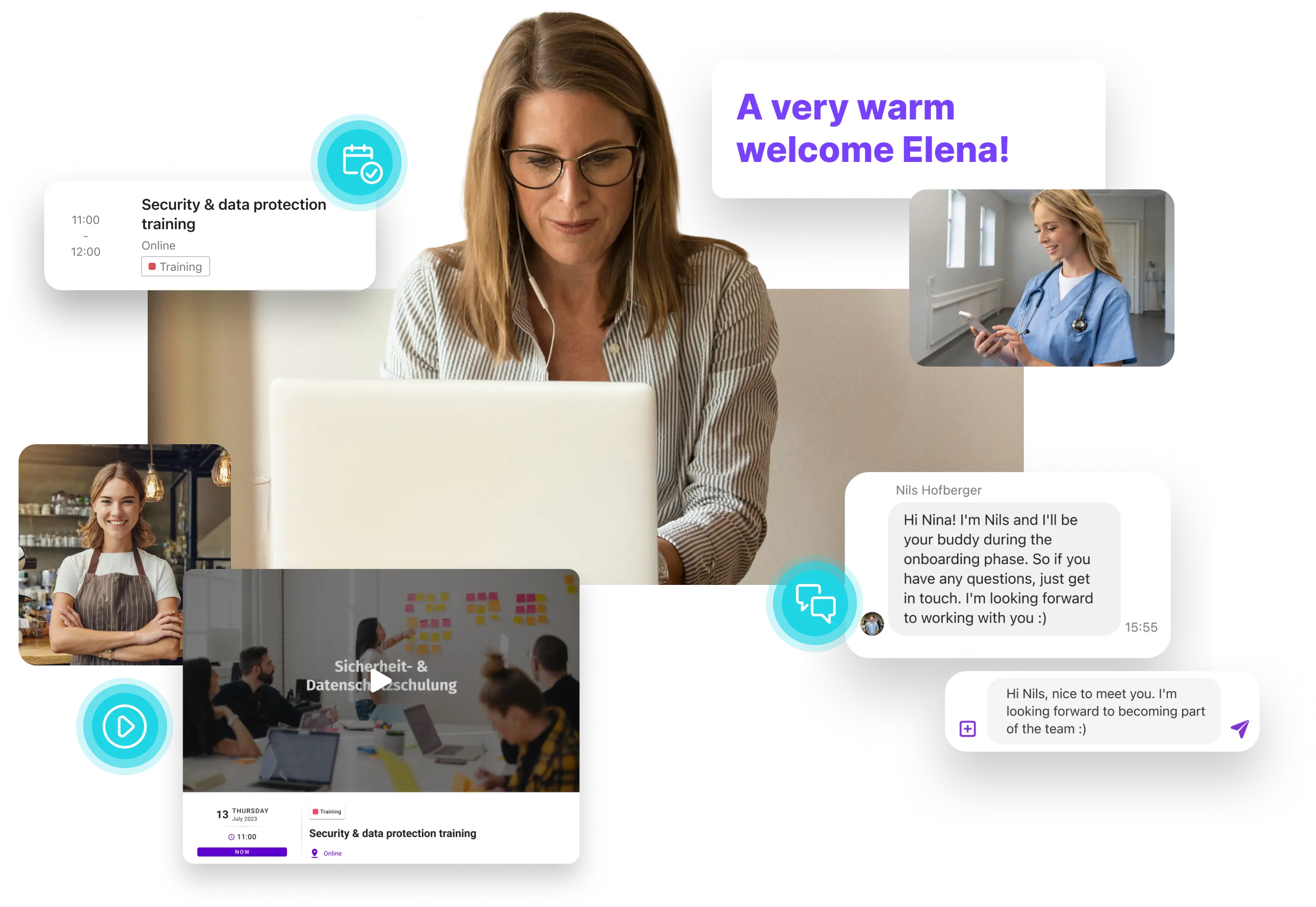Remote onboarding is now more important than ever as more and more companies switch to remote working. A well-designed onboarding process ensures that new employees feel welcome from the outset and quickly become productive. But how can this be achieved if there is a lack of personal interaction?
The biggest challenges in remote onboarding are ensuring that new employees feel connected and integrated despite the physical distance. In addition, technical equipment and access must be provided smoothly. However, these challenges are also accompanied by many opportunities: digital tools and innovative approaches can make the onboarding process more efficient and exciting.
In this blog post, we will show you how to optimally prepare for remote onboarding, which tools and platforms are suitable for virtual welcome events and how to establish an open communication culture. We also cover mentoring systems and integration into the corporate culture. Let’s explore these exciting topics together and get the most out of your remote onboarding!
Successful remote onboarding starts with good preparation
Successful remote onboarding starts with careful preparation. It is crucial that technical requirements are met and that the process is well planned and organised.
To ensure that new employees can get off to a smooth start, all the necessary technical equipment and access points must be provided. This includes a working laptop and access to relevant software tools. It is advisable to provide technical support before the first working day in order to solve any problems quickly.
A structured onboarding plan helps to organise the process clearly and efficiently. This includes a detailed checklist that covers all steps of onboarding, such as induction events and regular feedback meetings. The plan should also include fixed contact persons who are available for questions and support. A well-organised schedule ensures that new employees are not overwhelmed and can settle into their new roles step by step.
Creative virtual activities for successful remote onboarding
Organise a special day where all new remote team members come together to get to know the company and their colleagues. This day can include a mixture of informative sessions and interactive activities.
Organise a special day where all new remote team members come together to get to know the company and their colleagues. This day can include a mixture of informative sessions and interactive activities.
Plan regular informal coffee breaks where new employees can chat to their colleagues in a relaxed atmosphere while working from home. These breaks promote social contact and help to build personal connections.
Integrate interactive games or icebreaker activities into your welcome meeting, such as "Two truths and a lie" or a virtual quiz. These activities loosen up the atmosphere and encourage people to get to know each other in a fun way.
Organise a virtual escape room as a team-building activity. This promotes cooperation and communication among the new employees and is fun at the same time.
Invite the new employees to a virtual lunch, send them meal vouchers in advance or organise a joint order so that everyone can eat at the same time. This creates a relaxed and sociable atmosphere.
Offer short virtual wellness sessions, such as guided meditation or stretching exercises. These activities can help to reduce stress and promote a positive mood.
Communication in remote onboarding
Effective communication and collaboration are essential for successful remote onboarding. Especially for new employees starting remotely, it is important to establish clear communication channels and an open communication culture to ensure smooth integration.
For formal communication and the passing on of important documents, e-mail remains an indispensable tool that ensures that new employees always have the necessary information to hand. Tools such as Slack or Microsoft Teams offer fast and informal communication options and are ideal for daily updates, quick questions and spontaneous exchanges, which is particularly important in the initial phase of onboarding. Regular video conferencing is essential to enable face-to-face interactions, create a sense of connection and avoid misunderstandings. These can also be used for virtual “face-to-face” introductions and training sessions. Specialised onboarding apps serve as a central platform for all onboarding activities. They provide a central point of contact for all important information and enable new employees to find their way around quickly. These apps also include communication functions such as chats and channels that facilitate dialogue and networking.
Establishing an open communication culture
An open communication culture is essential to promote trust and cooperation. Schedule regular check-in meetings to discuss the progress and facilitation of new employees. The meetings should provide space for questions and feedback and help to customise the onboarding process. Encourage new employees to share their experiences and suggestions. Anonymous surveys or regular feedback sessions can help to obtain honest and constructive feedback. This is particularly important in order to recognise and rectify potential difficulties at an early stage.
Establish a mentoring or buddy system in which experienced employees support new colleagues. These personal connections promote trust and help new employees to find their feet more quickly. Keep all employees informed about important decisions, company goals and changes. Transparency strengthens trust and helps new employees to feel part of the team. Organise virtual team activities to strengthen cohesion and promote integration. These can range from informal coffee breaks to structured team-building events.

Use of onboarding apps to support remote employees
Onboarding apps are specially developed to integrate new employees into the company quickly and effectively. These apps bundle all the necessary information and resources in one place and make them easily accessible. Here are some of the advantages that onboarding apps offer:
Onboarding apps provide a central point of contact where all important documents, manuals and resources are stored. New employees can access this information at any time, which makes it easier to get started and clarifies many questions in advance.
Many onboarding apps offer interactive training modules and e-learning courses that help new employees to quickly acquire the skills and knowledge they need. These modules are often flexible and can be worked through at your own pace.
Onboarding apps promote communication and networking by providing platforms for dialogue with colleagues and mentors. Functions such as chats, channels and virtual meeting rooms make it easier to build relationships and work together.
Examples of useful functions
Feedback tools
These are important in order to continuously improve the onboarding process. These tools enable new employees to share their experiences and suggestions directly in the app. Regular feedback helps to adapt the process and respond to individual needs. This can be done, for example, by inserting formulas.
Social features
Functions such as an employee directory, profile pages, chats and social feeds within the app promote networking and social exchange. This makes it easier for new employees to socialise, integrate more quickly into the team and ask questions.
Central contact point
A central point of contact for all onboarding materials is essential. Here, new employees can find all relevant information at a glance, from company guidelines and team structures to important company news and specific tasks.
Checklists & task tracking
Interactive checklists and task tracking tools help new employees to keep track of their onboarding tasks. They can track their progress and ensure that they go through all the necessary steps.
Communicating corporate culture at a distance: Strategies for remote employees
Communicating the corporate culture to remote employees is crucial for their long-term integration and satisfaction. Clearly defined values, vision and mission should be clearly communicated and regularly shared via digital platforms. A well-designed welcome page in an onboarding app can be very helpful here.
Regular communication keeps all employees informed about current events in the company and promotes a sense of belonging. Managers should exemplify and actively promote the corporate culture through regular virtual meetings and open communication in order to strengthen trust and the connection with employees.
Virtual induction events that present the company’s history, successes and future plans can inspire new employees and give them a better understanding of the corporate culture. Mentoring programmes or buddy systems can also help new employees to understand the corporate culture more quickly and find their way around the company better.
Through these strategies, companies can ensure that their corporate culture is effectively communicated remotely and that remote employees feel like valuable members of the team.
Conclusion: Successful remote onboarding
Successful remote onboarding requires careful planning and the right mix of technology and human interaction. Providing the necessary technical equipment and using specialised onboarding apps ensures that new employees quickly find their way around. Clear communication channels and regular virtual meetings promote a sense of belonging and strengthen trust. Virtual activities and team-building measures help to strengthen social ties and communicate the corporate culture.
A mentoring or buddy system helps new employees to settle in more quickly and clarify any unanswered questions. Regular check-ins and feedback loops make it possible to continuously improve the onboarding process and respond to individual needs.
With these measures, organisations are creating a positive and supportive environment where remote workers can perform at their best from day one. A well-structured onboarding process lays the foundation for long-term satisfaction and success, both for new employees and for the company as a whole. By investing in effective remote onboarding, you can ensure that your team is well equipped for a decentralised working environment.


